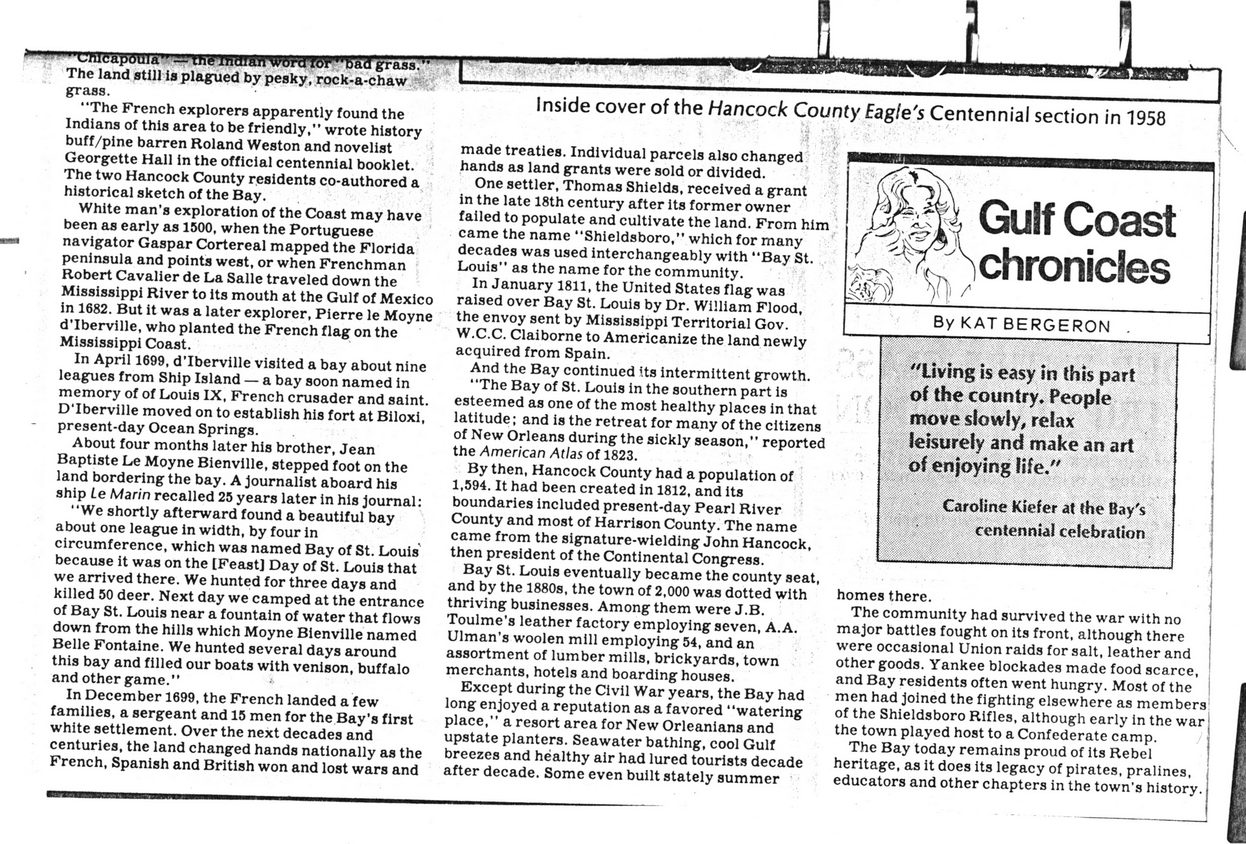This text was obtained via automated optical character recognition.
It has not been edited and may therefore contain several errors.
—LTOCapWlll" '-U tHBlHBim WUl'U Ibl1 "BAfl grass'? The land still ia plagued by pesky, rock-a-chaw « grass. “The French explorers apparently found the Indians of this area to be friendly,” wrote history buff/plne barren Roland Weston and novelist Georgette Hall in the official centennial booklet. The two Hancock County residents co-authored a historical sketch of the Bay. White man’s exploration of the Coast may have been as early as 1500, when the Portuguese navigator Gaspar Cortereal mapped the Florida peninsula and points west, or when Frenchman Robert Cavalier de La Salle traveled down the Mississippi River to its mouth at the Gulf of Mexico in 1682. But it was a later explorer, Pierre le Moyne d'lberville, who planted the French flag on the Mississippi Coast. In April 1699, d'lberville visited a bay about nine leagues from Ship Island — a bay soon named in memory of of Louis IX, French crusader and saint. D'lberville moved on to establish his fort at Biloxi, present-day Ocean Springs. About four months later his brother, Jean Baptiste Le Moyne Bienville, stepped foot on the land bordering the bay. A journalist aboard his ship Le Marin recalled 25 years later in his Journal: "We shortly afterward found a beautiful bay about one league in width, by four in circumference, which was named Bay of St. Louis' because it was on the [Feast] Day of St. Louis that we arrived there. We hunted for three days and killed 50 deer. Next day we camped at the entrance of Bay St. Louis near a fountain of water that flows down from the hills which Moyne Bienville named Belle Fontaine. We hunted several days around this bay and filled our boats with venison, buffalo and other game." ' In December 1699, the French landed a few families, a sergeant and 15 men for the Bay’s first white settlement. Over the next decades and centuries, the land changed hands nationally as the French, Spanish and British won and lost wars and Inside cover of the Hancock County Eagle's Centennial section in 1958 ■K 1\ made treaties. Individual parcels also changed hands as land grants were sold or divided. One settler, Thomas Shields, received a grant in the late 18th century after its former owner failed to populate and cultivate the land. From him came the name "Shieldsboro,” which for many decades was used interchangeably with "Bay St. Louis” as the name for the community. In January 1811, the United States flag was raised over Bay St. Louis by Dr. William Flood, the envoy sent by Mississippi Territorial Gov. W.C.C. Claiborne to Americanize the land newly acquired from Spain. And the Bay continued Its intermittent growth. "The Bay of St. Louis in the southern part is esteemed as one of the most healthy places in that latitude; and is the retreat for many of the citizens of New Orleans during the sickly season,” reported the American Atlas of 1823. By then, Hancock County had a population of 1,594. It had been created in 1812, and its boundaries included present-day Pearl River County and most of Harrison County. The name came from the signature-wielding John Hancock, then president of the Continental Congress. Bay St. Louis eventually became the county seat, and by the 1880s, the town of 2,000 was dotted with thriving businesses. Among them were J.B. Toulme’s leather factory employing seven, A. A. Ulman’s woolen mill employing 54, and an assortment of lumber mills, brickyards, town merchants, hotels and boarding houses. Except during the Civil War years, the Bay had long enjoyed a reputation as a favored “watering place," a resort area for New Orleanians and upstate planters. Seawater bathing, cool Gulf breezes and healthy air had lured tourists decade after decade. Some even built stately summer Gulf Coast chronicles By KAT BERGERON . ''living is easy in this part of the country. People move slowly, relax : leisurely and make an art of enjoying life." Caroline Kiefer at the Bay's •' \ / centennial celebration homes there. j The community had survived the war with no , major battles fought on its front, although there j were occasional Union raids for salt, leather and ! other goods. Yankee blockades made food scarce, and Bay residents often went hungry. Most of the men had joined the fighting elsewhere as members of the Shieldsboro Rifles, although early in the war the town played host to a Confederate camp. The Bay today remains proud of its Rebel heritage, as it does its legacy of pirates, pralines, educators and other chapters in the town's history.

BSL Centennial 1958 一Document (051)